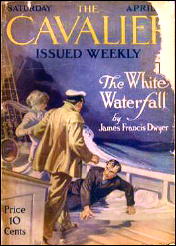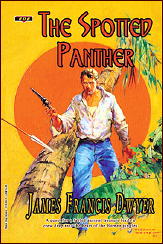Sun 28 Feb 2010
A Review by Walter Albert: JAMES FRANCIS DWYER – The White Waterfall.
Posted by Steve under Pulp Fiction , Reviews[10] Comments

JAMES FRANCIS DWYER – The White Waterfall. Doubleday Page & Co., 1912; illustrated by Charles S.Chapman. W. R. Caldwell & Co., hc, International Adventure Library: Three Owls Edition. Serialized in The Cavalier in four parts, beginning 13 April 1912. Readily available in various Print on Demand editions and as an online etext.
Australian writer Dwyer was a welcome regular in Blue Book Magazine in the 1930s, and this early South Seas adventure novel is a fine example of his robust, colorful narrative style.
The remote, isolated island to which the characters travel, is thought to be uninhabited, but there are structures that pre-date the memory of any race that left written records, and a small group of natives perform ceremonies and make human sacrifices in the name of some savage God. This may remind some of a certain celebrated RKO film released in 1933, but the terrors are all too,human and no giant remnants of an earlier age live in the depths of the jungle.

The protagonist, and narrator, Jack Verslun, an itinerant seaman, is hired to serve on a ship chartered by Professor Herndon, an obsessive scientist who has brought along his two attractive daughters on what turns out to be an ill-advised and dangerous voyage to “The Isle of Tears,” which a rough-looking rogue named Leith has promised the Professor will yield scientific wonders that will make his reputation.
The party, aside from a largely native crew, is completed by Will Holman, a feisty young American who — the son of the owner of the chartered boat they are traveling on — is along for the heck of it and for the love of the younger of the two Herndon girls, Barbara. An older daughter, Edith, is useful for completing a quartet that I needn’t spell out for you.

They reach the island after a terrific storm and when Jack is ordered to stay on the boat while Leith takes a small party to the island, concerned about Leith’s intentions, he jumps ship, catches up with the party and finds himself, Will, and the Professor and his daughters, in a situation that takes them to the brink of disaster.
Dwyer is not, perhaps, as polished a stylist as John Russell, who wrote notable stories about adventures in the South Seas, but the slightly, pulpy cast of his story is perfectly pitched to drawn in a sympathetic reader, with the pace, once the horror of Leith’s intentions becomes clear, resembling the frantic drive of the flight through the jungle to the ship and escape of the earlier noted King Kong.
Editorial Comment: A brief biography of the author appears online at the Pulprack website, with another appearing here.
And of special note to anyone reading this blog is The Spotted Panther, also by Dwyer, has recently been published in a handsome softcover edition by Black Dog Books. Highly recommended!
February 28th, 2010 at 11:04 pm
Sadly none of Dwyer’s books are available on-line at the Project Gutenberg Australia SF site, but it’s good to know this one is available in an attractive edition. There are many good works of Australian popular fiction deserving to be better known this side of the equator.
March 1st, 2010 at 12:00 am
I like Dwyer’s work and read THE WHITE WATERFALL in CAVALIER. Two more favorites are CARAVAN TREASURE in Blue Book, 1936 and THE TREASURE OF THE VANISHED MEN, also Blue Book, 1937. Somehow I managed to find one of the original pieces of art by John Richard Flanagan illustrating a scene in one of the serials. I still have it unlike my stupid decision to sell my CAVALIER set.
March 1st, 2010 at 10:46 am
Text version with illustrations available from Project Gutenberg: http://www.gutenberg.org/files/10862/10862-h/10862-h.htm
March 1st, 2010 at 7:01 pm
Since my comment I’ve also found THE SPOTTED PANTHER with illustrations available at GOOGLE BOOKS to read on-line or download in PDF or EUPB formats. Perhaps Dwyer isn’t available on the Australian site because he is still under copyright there?
By the way, the Australian Gutenberg SF site is a fine source for rare sf and thriller material, some of which can’t be found elsewhere. You might also check out the Canadian Gutenberg site for a few things not found elsewhere.
March 1st, 2010 at 9:12 pm
Walker
You sold your CAVALIER set? What prompted that decision? How easy do you think it might be to accumulate another set? Not very, in my opinion!
EGM3 and David
Dwyer’s an Australian author, which is why (I agree) you can find his work on the Gutenberg site in the US, and not on the Australian one.
And strangely enough, copyright laws being as quirky as they are, the opposite is true. There’s quite a bit of material on the Australian site not available in the US. I suppose somebody could try to explain it all to me again, but since it hasn’t stuck the first 15 times, there’s no reason to hope that the 16th will help.
March 2nd, 2010 at 12:14 am
Don’t ask me to explain the laws. Much of Sayers is available on the Canadian site but not the American one.
Anyway, for those of us who don’t mind reading on-line or on the PC (and I’ll grant a lap-top is a blessing in that) there is so much available that has saved me a small fortune. Not that I wouldn’t rather have the physical books, but considering the rarity and price of many of the volumes it is hard to complain about free.
If nothing else it is a good way to preview books you may not be sure you want to acquire, or read something that’s impossible to find even on the Net.
But I certainly understand those who don’t like to read e-books on the PC or one of the growing number of readers. It will never replace a book.
3.
March 2nd, 2010 at 1:17 am
Steve asks about my CAVALIER set of pulps and would it be possible to build up another set.
I’ve always believed collectors have to be moving on and expanding their interests. Once you reach your goal and complete your collection, then often the next step is you start to dismantle it. So I’ve always kept adding titles to collect. I really don’t understand collectors who can limit their collecting activities to one author or even one genre.
I started out as a teenager collecting SF and this lasted until my mid twenties when I discovered detective pulps, thanks to Ron Goulart’s HARDBOILED DICKS anthology. I also picked up massive amounts of vintage paperbacks because back then they were so cheap. Then at the first Pulpcon in 1972 I discovered general fiction magazines like ARGOSY, ALL STORY, ADVENTURE, BLUEBOOK, SHORT STORIES, POPULAR. Around 1980 I added western pulps.
Eventually I completed my sets or just about completed them, something I never thought would happen, and reached the point that I really didn’t need any major wants. Then I started to dispose of certain sets that I found I could no longer read. For instance, I found that the hero pulps and weird menace pulps were not that readable anymore. Also I finally reached the point that I had filled up a five bedroom house, including the basement, living room and family room, etc. My son’s room is the only holdout.
I’ve been at this since the 1950’s and now I’ve run out of space and since I’m getting older, I’m running out of time. So I started disposing of things but once a collector, always a collector. It never ends until the end.
So the CAVALIER set was one of the victims around 10 years ago. Since I filled the shelf space right away with other magazines, Steve probably never noticed they were gone. The reason I regret letting them go is because I still have my ALL STORY and ARGOSY sets and CAVALIER is all part of the Munsey chain of magazines. How hard would it be to replace? Just about impossible nowadays.
I see I’ve turned this into a rambling essay, but collecting books, pulps, and vintage paperbacks, is something I’ve always felt passionate about. I won’t even get into original art or old movies. Now I have to leave because it’s 1:00 am and I have to get up at 5:00 am, but I want to squeeze in a Tim McCoy film, ACES AND EIGHTS.
March 2nd, 2010 at 2:30 am
Walker
Just looking on eBay, I found maybe six CAVALIER pulp magazines from the teens, some combined with ALL-STORY, and even for beat up copies, the lowest asking price was $50. A lot of two others has reached just less than that, but that’s an auction, and both copies have Edgar Rice Burroughs stories in them, and I have a feeling the price is going to go quite a bit higher.
Too bad I left my check book in my other pants.
As for ACES AND EIGHTS? Reviewed here, way back when:
https://mysteryfile.com/blog/?p=927
— Steve
March 2nd, 2010 at 11:56 am
For reasons too complicated to explain (or too embarrassing, on my part), Walker and David Vineyard’s sequence of comments following the last two posted above can be found here instead:
https://mysteryfile.com/blog/?p=1870#comments
September 2nd, 2011 at 3:17 pm
go to link below for an on-line version of Dwyer’s collection of short stories, Breath of the Jungle, which includes his wonderfully chilling short story, A Jungle Graduate.
http://www.archive.org/details/cu31924008156089